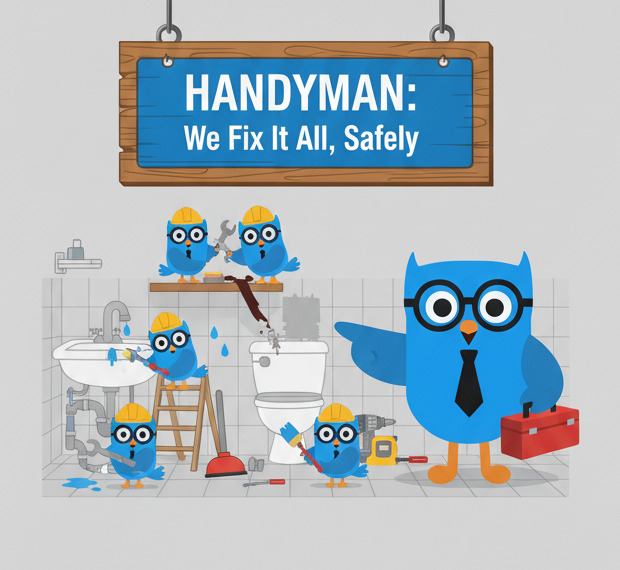Handyman Insurance: Coverage Every Jack-of-All-Trades Should Have
Mr. Hoots breaks down what coverage keeps handymen protected when the to-do list turns into an “uh-oh” list.
Hoo’s there? Mr. Hoots here, your trusty insurance bird with a hammer in one wing and a policy in the other. Handymen keep homes running, fixing everything from leaky faucets to loose railings. But even the most skilled fix-it folks can’t repair a lawsuit or replace stolen tools without the right coverage. Let’s talk protection that fits your trade like a perfectly driven screw.
What kinds of risks do handymen face?
- Property damage – you fix one thing and accidentally break another.
- Injuries – ladders, power tools, and tight spaces can turn risky fast.
- Tool theft – your truck doubles as a workshop, and tools aren’t cheap.
- Client complaints – even small jobs can lead to big liability if expectations aren’t met.
Key coverages to have in your toolbox
- General Liability (GL) – covers property damage or injuries you cause while on a job.
- Tools & Equipment Coverage – protects your portable gear wherever you go.
- Workers’ Comp – if you’ve got helpers or subcontractors, it’s a must (and often required).
- Commercial Auto – covers your work van, materials, and any mishaps while driving between jobs.
Common claims in the handyman world
- Drill or saw damage to a client’s countertop or wall
- Ladder falls resulting in injury (to you or others)
- Unsecured work area causing someone to trip and fall
- Paint or chemical spill on flooring or furniture
- Tool theft from an unlocked vehicle or job site
Every one of these is more common than you think—and without the right coverage, you’ll be paying out of pocket faster than you can say “trip hazard.”
Contract requirements you’ll see often
Most property managers, homeowners’ associations, or general contractors will ask for:
- Certificate of Insurance (COI) listing them as “Additional Insured”
- Proof of Workers’ Comp (even if you’re solo)
- Minimum liability limits ($1M per occurrence is standard)
- Hold harmless agreements built into your contracts
Having your paperwork ready not only keeps jobs legal, it makes you look professional and trustworthy.
Coverage mistakes to avoid
- Listing tools on your homeowners’ policy – won’t cover business use or theft from your truck.
- Not reporting helpers – unlisted subs or assistants can void Workers’ Comp coverage.
- Using personal vehicles for business – personal auto policies often deny claims if the accident happens while working.
- Underinsuring liability – cutting corners here can cost more than any repair job you’ll ever do.
Quick safety wins (that also help your rate)
- Keep cords and ladders secured at all times.
- Store chemicals and paints in separate bins.
- Document before/after job photos to protect against false claims.
- Mark work zones clearly when in client homes.
Mr. Hoots’ Bottom Line
Handymen fix problems for everyone else, it’s time your insurance fixes problems for you. With the right coverage, every screw-up (pun intended) becomes just another lesson learned, not a financial nightmare.

